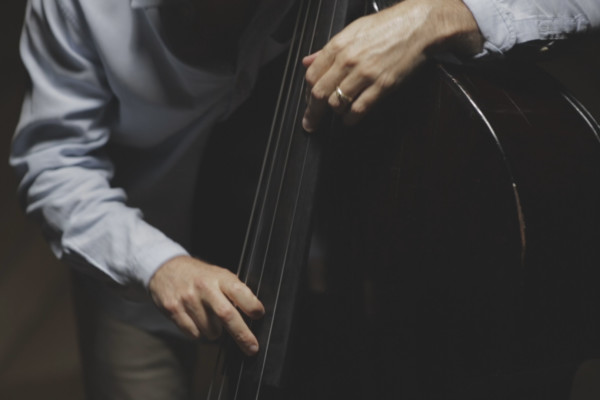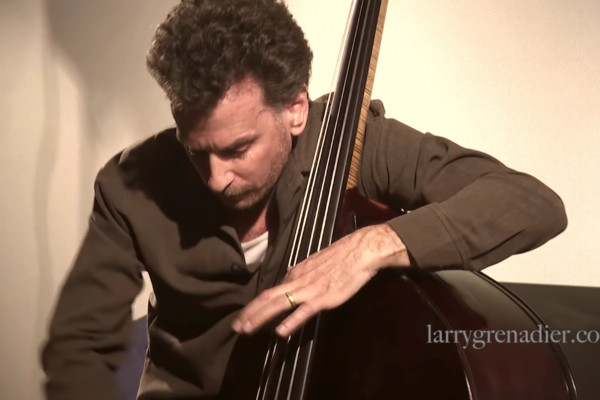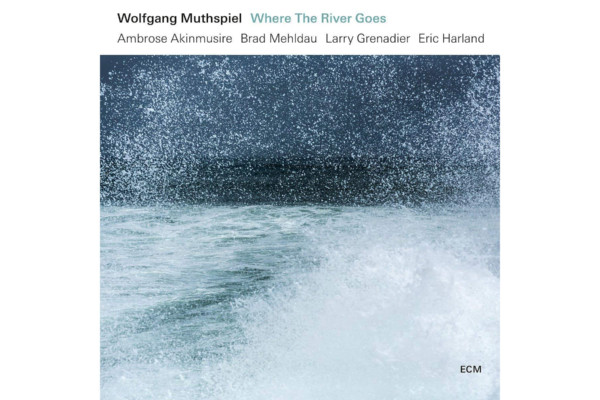The Gleaners: An Interview with Larry Grenadier
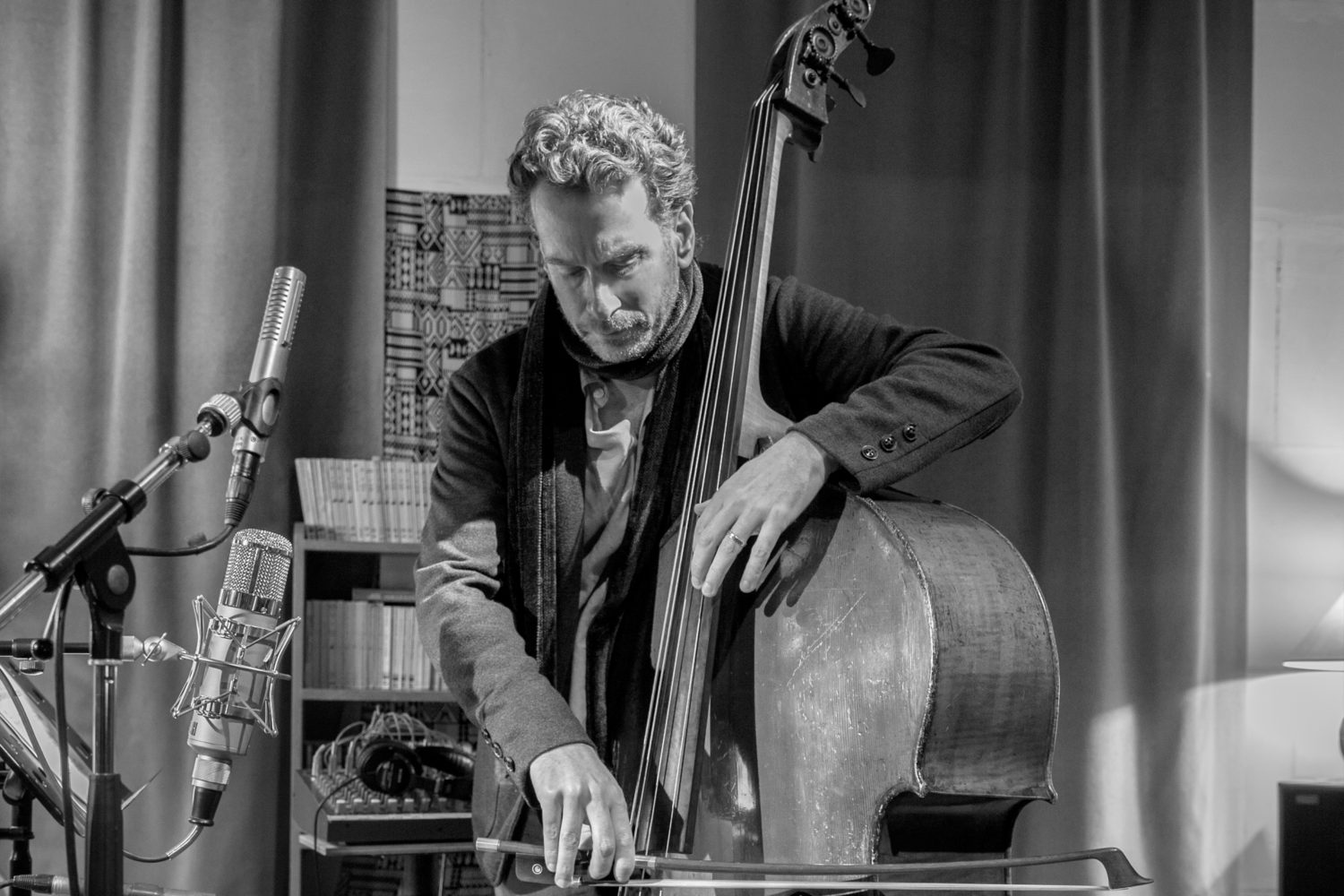
Larry Grenadier has been working alongside some of the world’s top musicians for three decades. Stan Getz, Brad Mehldau, Pat Metheny, and many more have kept the bassist in their bands for his clear, solid bass playing and unique voice on the instrument. Now, after all those years, he’s released his first album under his own name called The Gleaners on ECM Records, and the wait was worth it.
Grenadier’s deep melodic, harmonic, and rhythmic senses are on full display on the effort, which acts as a sort of self-portrait. In fact, they’re the only thing on display because The Gleaners is a solo bass album. That may sound like a one-dimensional venture to some, but in truth Grenadier’s palette of sounds and textures is so rich that you forget any stigma attached to the instrumentation.
“I experimented with various tunings and scordatura, like the 17th- and 18th-century violinists used, to get a full range of sounds – and that ended up giving the instrument a whole new vibration for me, a feeling of real sonic potential,” the bassist said.
The Gleaners is undoubtedly a masterpiece for solo bass that future records will be judged against. The opening track, “Oceanic”, is enough to captivate any skeptics, but each time you listen as a whole reveals nuances that you missed before.
We caught up with Grenadier to understand the process of making the album, his fascination with sonic variety, his basses, and his early influences.
The Gleaners is available on CD, vinyl and as a digital download (iTunes and Amazon MP3). Grenadier is having an album release party at the Zürcher Gallery in New York City on March 15th.
You wrote in the liner notes for this album that you’re “excavating the core elements of who I am as a bass player,” so who are some of the other early influences that planted that musical DNA in you?
There are so many. Like all of us, I just soak up everything I can. Some of it is by chance and some of it is by work and searching things out. When you’re young, things just come to you and you deal with them as you are able to.
Ray Brown was an example of that… [He was] the first upright bass player I ever saw live before I was even playing upright. He was someone who I could tell was super badass but I didn’t know why. I didn’t know his history with the instrument or anything like that. It’s such a curious thing to be looking back so many years later to see how we still connect with things that affected us at a very young age. We can’t just say we were young and didn’t know any better. We already had a sense of taste and the way our aesthetics were going to develop eventually.
My brother got into jazz before I did so I got to it from him and my father. [I was into] all the Miles Davis records with Paul Chambers and Ron Carter, the Coltrane records with Jimmy Garrison. Sam Jones came to me really early just by chance, and Oscar Pettiford, too. It was one of those things where you see an album cover and dig it for some reason. For me, there was an Oscar Pettiford record where I liked the cover so I bought it. I could connect with him because of the clarity of the way he played. He always spoke so clearly on the bass and made the harmonic and melodic elements of the bass come out really noticeably for a 13-year-old. The same thing for Charlie Haden, I’d say.
Then there were the contemporary guys in the ’80s like Marc Johnson, Eddie Gomez, Dave Holland, Gary Peacock, and George Mraz. These were people I could see live and maybe get a lesson from who affected me for their modern way of playing. Not that I looked at it like that at the time. It was just another way to play the instrument. It was really a combination of those contemporary bass players with all these classic bass players [that formed my playing].
Was there a specific lesson with one of those players that stuck out with you?
Well, I didn’t really take jazz lessons. There was a program at Stanford University that’s a jazz workshop where basically Stan Getz’s band would teach for the week. George Mraz and Marc Johnson were two bass players that were playing with Stan at that time. I did take lessons with them for that week. I also went to a Jamey Aebersold camp when I was really young and took lessons with Todd Coolman and John Goldsby.
All the lessons I had growing up were classical lessons. Even with the jazz teachers I had in San Francisco, we didn’t talk about jazz. It was all learning how to play the bass through a classical regimen. A few years later when I was in college I took lessons with classical bass players in the San Francisco Symphony where it was really about learning how to get around the instrument and the physicality of playing. The jazz stuff, I really got from listening and watching.
That seems to be the way to do it. I think at some schools you take two years of classical before you even get to have jazz lessons.
It’s how everybody did it up until 30 or 40 years ago. Now everybody assumes you go to college to learn how to play jazz. Now that I teach, I see there is a lot that you can teach [about jazz], but a lot of the upright is about foundational technique and learning to get around the instrument. The jazz part of it still comes from listening and playing with your peers and transcribing.
The jazz teaching thing is still a bit tricky. You can only say so much about how to play on a blues. Most of my time as a teacher is spent to help students make it easier to play this physically demanding instrument. Then when you go to play with people, you don’t think, “Can I play that C# on the E string in tune?” You just do it, and then your ears are in the music. Your focus is not on your own inability to get the music out.
This is your first record under your own name, let alone your first solo bass album. How did this all come about?
I’ve been doing records for ECM over the years and working with Manfred Eicher in different situations. A few years back, I was recording with guitarist Wolfgang Muthspiel and after the session, Manfred asked if I’d like to do a solo bass record for him.
Truthfully, I had never thought of that. It was just the right timing for me. I grew up with a few of those solo bass records by Dave Holland and Miroslav Vitous and Gary Peacock. It intrigued me to think about how I would approach what the bass could do in that setting.
I had a year between agreeing to do it and recording it, which gave me time to re-explore fundamental issues of what music is and what bass means to me. During that year I explored different sonic ideas on the instrument between arco playing and pizz playing, just trying to bring out different sounds from the instrument and the techniques to get that clearly stated.
Exploring the sonic potential of the instrument has always been a big thing for me. This pushed me into new realms of that with seeing how different tunings affected the overall resonance of the bass and how playing certain double stops unfold on different parts of the instrument. Even just trying different pizzicato sounds and how we can get different timbres out of the instrument. During that year I explored all those options and then wrote some music that used those ideas. Then I practiced to make them speak as clearly as I could.
Recording it was a great learning experience for me and now performing it is going to be another lesson. It’s an interesting hour or so of music that not only bass players can hear it and follow. A solo bass thing is a little hard to ask of somebody, so I try to have some variety in there for whoever wants to join in.
I feel like you did a great job of varying texture a lot, even with the opening track, “Oceanic”.
That’s got a different tuning, which I guess you’d call Viennese tuning. From the top down it’s tuned F#, D, A, D. To have the third in there is nice, and there are quite a few tunings on the whole record. In general, what I found was that my ear appreciated tuning down rather than up. There’s a bass player that Manfred hipped me to named Barre Philips. I’d always known his name, but I didn’t know his music. There’s some solo bass playing where he’s playing a five-string bass with a high C that opens up another realm of sound closer to the cello. Exploring it myself, I tended to like the warmth of the sound when I tuned down.
Watching how the whole bass resonated differently with different tunings would inspire me just in that the bass sounded like another instrument: a bassoon or some darker woodwind. Those things were enough to make the music come out. That’s such a bass geeky thing to do, but that’s enough. Then you go from there and be inspired by that.
It seems like timbre and texture are what really motivate you.
Definitely. I usually don’t like to talk about strings because it’s such a personal thing that you have to figure out, but that was part of the sonic exploration, too. Different strings for bowing and for pizz. I’ve always been a fan of gut strings, but for [they are difficult to bow on], so I explored strings made for bowing. I’d never done that in my life – I’d always use jazz strings and try to make them work with the bow. Once you put strings on that are made for bowing, it’s a whole different world. Typically they’re darker and looser and they grab the bow hair. Then there was the technical side of which bass I use for each sound.
Since we’re talking gear a bit here, could you tell us about your basses?
Because I use different strings, I used two different basses on the recording. I used my old bass that I’ve had since 1994, which is an old German bass, for the arco stuff. For the pizzicato pieces, I used a new bass I bought a few years ago made by Ben Puglisi, who is a bass maker in Melbourne, Australia.
I set them up differently because they’re very different instruments. I’d say in general the German bass is darker sounding. It works well for classical, but I’ve always used it for all my jazz recordings. The new bass is quicker and the sound pops out faster. Now that I’m about to do some gigs like this, I’ve had to compromise because I don’t want to bring two basses. I’ve outfitted one bass with strings that work for both.
What were the difficulties of writing a solo bass album that you hadn’t run into before?
The first one that was surprising was that to be in the studio by yourself is a very different feeling. We’re always with people playing live or in the studio. I’ve gone in to do overdubs before by myself, but that’s always for a short period of time. Being in the studio for a couple of days by yourself was a startling revelation in that there’s nothing to react to except your own playing. It wasn’t a lonely experience, but it was a bit off-putting at first. I had to get through that pretty quick. Once I was in the studio I realized it’s such a different thing energetically. We’re just always used to being inspired by what’s coming at us from other people.
[Another obstacle was] just the nature of the instrument being, for the most part, a single-note instrument. Of course, you have double stops, but harmony unfolds over time with the bass. It’s not like a piano where you hit a chord and say, “Ah, that’s A major.” You have to play through the chord and over the course of that statement you hear that it’s A major. You have to be aware of the clarity of the information and how it’s unfolding through time. It’s not spontaneous.
This came up a lot with the band FLY with [saxophonist] Mark Turner and [drummer] Jeff Ballard, where there’s no chordal instrument. The default for the listener might be that we’re playing free all the time. Compositionally, we have to be aware of that issue and make things more clear. You’re just dealing with two voices: tenor sax and bass. That harmony has to speak clearly enough as a two-note sound. As a bass player who’s dealing with showing clarity of form and harmony, I have to represent it in a way that shows the form of the tune so it doesn’t sound like we’re randomly reacting to each other. It was a similar experience for me with the solo bass. Stressing the lack of vertical harmony and that horizontal harmony is cool, but you have to be patient.
That’s something that bass players probably struggle with a lot.
Yeah, because even if there is a piano player, we’re always dealing with form. What bass players typically get hired for is showing the form very clearly in creative ways. We can show harmony in many different parts of the chord as long as we’re clear about the voice leading of it. The only real jazz bass lessons I took were with Ron Carter, but they weren’t that long ago. It was maybe fifteen years ago for a couple of months. They were fantastic lessons that were amazing inspiring and long-lasting. The focus of most of it was bass lines and how to construct them. There’s no one I can imagine that would be better suited for going to for that information besides Ron. He’s able to teach it amazingly well. That pushed me into exploring it deeper by playing bass lines that have a strong functional role in showing harmonies, but are also unexpected and take the song in a different place. So I took some of that to this project in the sense of it being super functional sometimes while opening up some different doors along the way.
Would you say that applies a lot to the song “Pettiford”?
That’s actually a song I wrote for FLY. It’s written on the changes to Oscar’s song “Laverne Walk”, which is pretty much a G rhythm changes with a different bridge. I was just playing on that tune and this melody came out that is definitely not an early bebop kind of melody. It’s harmonically different and I wanted that kind of contrast. It’s a more chromatic melody over swing-oriented changes. When I went to do it for this record, I thought it’d be interesting to solo through the changes in an open way that’s still on that movement of harmony. Eventually, it falls into the melody at the very end.
It’s a nod to Oscar in the sense that what I appreciated about him so much was his clarity of playing the bass. He was so melodic and so consistent. Every recorded example of his is at a super, super high level, like Ray Brown or Ron Carter. But that clarity is something that stayed with me, so that was something I was striving towards. I wanted to have the harmony stated clearly but in the 2019 version of where I’m at now, harmonically.
I thought it was interesting that you included one track, “Woebegone”, that has multi-tracking while the rest don’t. When you were writing, did you hear that and want to add it? Where do you draw the line at a song’s finish point?
That was an initial decision I had to make early on. Am I going to make a record with a lot of overdubs or not? Nowadays everyone works with overdubs and it can be really fun, but I didn’t want to make that record. I decided to record so it was basically live, but there were a couple of ideas that came out that made me feel a little bit of [overdubbing] would be interesting. That was one of them where another melody came out that I wanted to somehow represent and overdubbing was the way to do it.
I wrote “Woebegone” on acoustic bass guitar and wanted it to be like a guitar player sitting down by the fire to play a song. I wanted to get a sound out of the bass not necessarily how a classical bass player plays pizzicato, but somewhere between that and the way a guitar player plucks. I wanted to get that vibe. The hardest part of that tune is that now I have to play it live. [laughs] It’s a little tricky fingering-wise. The little solo section where there are three basses soloing at once just kind of happened. I wasn’t thinking about doing that, it just happened and I dug it.
How much of that spontaneity is on this album?
I don’t know if you saw the Quincy Jones documentary, but in the film, he said that you have to leave fifteen to twenty percent of recording to magic in the studio. The problem with the studio is that it’s really clinical. You have to prepare so much so you don’t mess up, but the negative there is that you don’t leave any room for the magic. As jazz musicians, we’re prepared for that anyhow because that’s how we go about it. Because some of the album is through-composed, I kept it in mind that I wanted some of the tunes open to see what happens in the studio. That was very important to me because at heart I’m a jazz musician and that’s what I love about jazz. It’s so reactive and inclusive. We practice and practice just to be ready for the unexpected if we’re willing to put ourselves in that position. Playing solo is off-putting at first because you’re playing in a room by yourself, but I still wanted to have those environments ready where I could be surprised by what came out and then react to it. There were definitely quite a few moments that were just capturing me reacting to what I played.
As a listener, my favorite records always have that – even the pop and rock records. To me, the best records have that. I’m always searching for that compositionally and playing-wise to let that happen.
That’s an interesting tightrope walk you have to do.
Right, and that’s why we practice. We have to be ready for what comes out. I love electric bass and R&B and rock. I love all types of music. Jazz musicians tend to listen to everything. Not to make a political statement, but I think pop musicians and classical musicians would benefit by listening to more jazz to get a deeper understanding of what’s going on. Not that they need to play it, but I think there’s a certain thing that goes on with jazz musicians as they practice to prepare for this way of playing that all musicians would benefit. Then the music would be much more in the moment.
It’s happening more than it was 30 years ago, but I encourage it more and more. Especially in universities where the music departments are continuing to be divided. Jazz and classical departments have very little to do with each other and that makes it hard for students to live in both worlds. It makes no musical sense and I think it’s a disservice to all music. Since the bass functions in all those worlds – classical, jazz, pop, country – we’re in a nice place where we can clearly see how music is united. There’s a function of the instrument that is fundamentally the same. There’s no reason for us not to be inspired and encouraged by what happens in other fields and let that help push the music further. It’s a pet peeve of mine and bass players have a good position to encourage people who are into all music to see what unifies it. It’s really all the same.
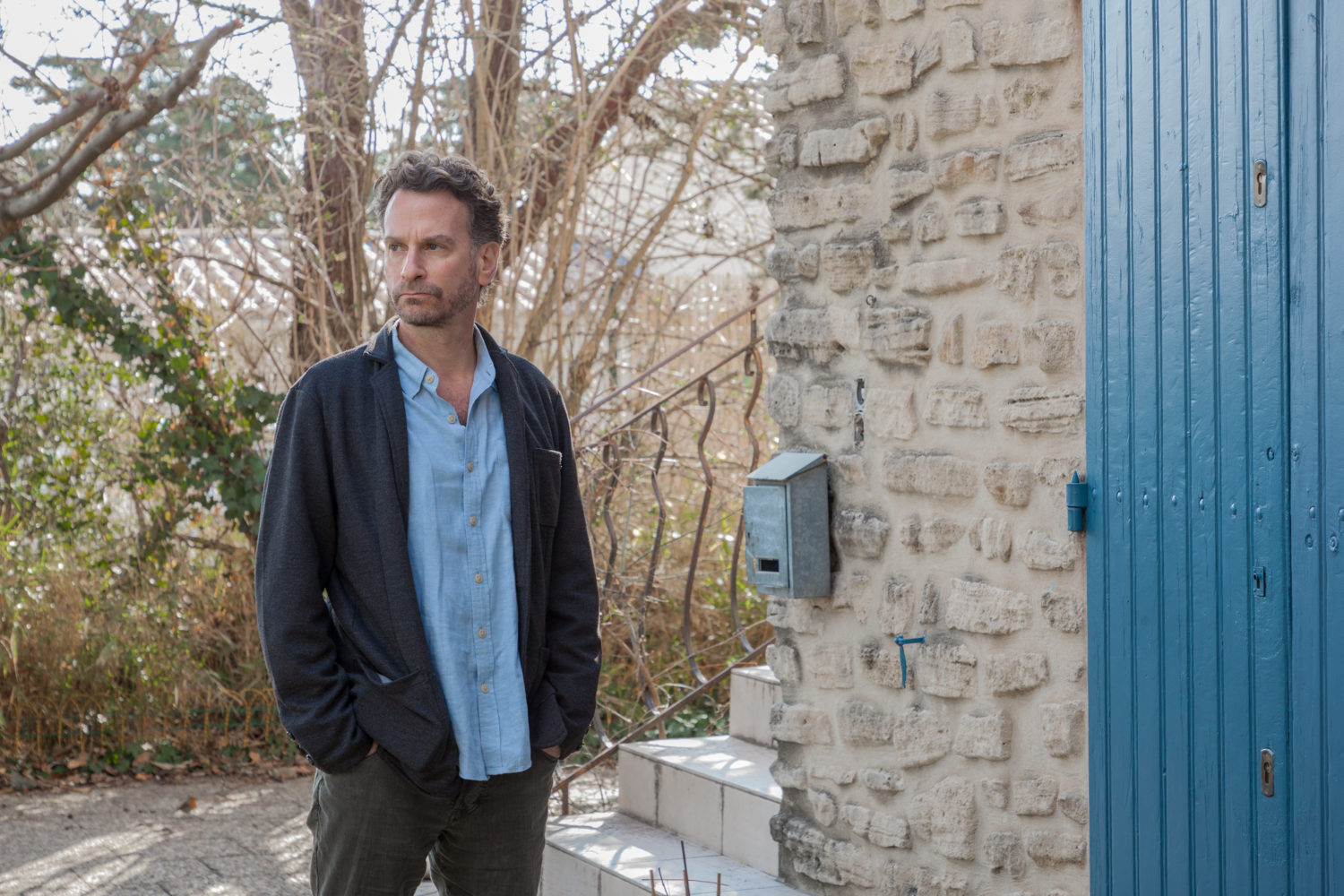
Was it new for you to interpret your wife Rebecca Martin’s song, “Gone Like the Season Does”, on your own?
That’s a song of hers I always liked but I had never played with her. I’ve always appreciated her writing very much for the way it combines a strong melodic statement with harmony that is interesting enough to improvise on. It’s always been an enjoyable learning experience to play with singers, but especially with her. To have that connection with your spouse is very unique. I wanted to do something of hers and I chose that tune even though I hadn’t played it before because I liked it so much, plus the harmony was interesting enough to expand on once the melody was stated.
That’s always the search for jazz musicians. We find tunes that might be outside of the genre that have all the things we’re looking for: melodic, harmonic, or rhythmic material we can expand on. That’s why jazz musicians go back to all these old standards because they have catchy melodies with harmonies that are unique. You can play 32 bars over and over and over and not get bored of it.
That’s why the bass was so prevalent up through the ’60s in pop music. It was always louder than the drums in the mix, but then that switched. I think part of why that switched is that the harmony went out the window and there’s no need for a bass if there’s no harmony. Why not just have a low-tuned drum, then?
Speaking of standards, I’m sure you know tons of them. One of them you have is “My Man is Gone Now”. What made you add that song to the album?
I think it’s a really unique tune. It’s Porgy and Bess, it’s Gershwin, it’s been played by the greats. The Miles Davis and Gil Evans version was super inspirational. Lyrically and harmonically it’s very different than other Gershwin tunes. There’s that Miles version, but after he came back after he took some time off in the early ’80s, he had this new band with Marcus Miller and Al Foster. I really love that band. They were playing it and I loved their version. I felt like that particular band for Miles is kind of neglected now. People don’t really talk about that band and what they got to.
All the band members were still jazz musicians but they were playing groove-based music. That combination of influences only happened because of the particular personalities of all those people in the band. I just think it really stands out and it hasn’t been dealt with. To me, Marcus is one of the great musicians of our time. When he plays jazz, it’s deep. It’s not just on the surface. He has such a foundational understanding of the music mixed with incredible technique and groove. He’s a great example of how bass can show this cross-genre jumping. He’s so complete and he was complete when he was 19.
I also found it interesting that you put together John Coltrane’s “Compassion” and Paul Motian’s “The Owl of Cranston”. How did you come to that?
That Trane tune comes from The Meditation Suite. By that time, his band was playing much more open behind him and his sound had changed. That period from him is just so spiritually deep. The band is just rumbling beneath him and Jimmy isn’t playing quarter notes. It’s modal and there’s a pulse to the beat, but there’s no metronomic beat going by.
Playing with Paul showed me that way of playing in a direct way. You can feel the time, but it’s very loose and you’re still playing through the song. There’s an underlying beat, but it’s not metronomic. To me, there’s a connection between the way Paul played and the way that Trane was playing at the end of his life. That connected those two tunes for me.
What was it like working with Manfred?
I’ve been working with him for 20 years. There’s no one else I’d think of doing this record with, honestly. I have a lot of trust in his ears. He really hears music very deeply and broadly. Sonically he really hears the double bass and how it should be recorded and the space that surrounds it that makes it what it is. I knew that I could totally trust him in the process and the finished product would be an accurate representation of what I hoped it would be.
As far as musically, he had nothing really to say. I just did what I did, but he was able to capture it. His records are known for a bit of reverb, but with solo bass, you want a little bit of that, especially for the arco stuff. I felt confident he would be able to do that in a way I’d be comfortable with. It was a very easy relationship. I always enjoy working with him. He can have very strong opinions, but I have to say I almost always agree with what he says. If I don’t, then we have a discussion and deal with it. It was an old school way of doing records because he was very active. He was the right guy and the right label.
So you’re doing some solo shows in support of the album?
I’ve got one in New York City, one at a festival in Knoxville, Tennessee. Then I’ll be doing some out west in the States and then some in Europe. It’s coming together. We have to find the right venues because it has to be the right space. It will be interesting to see what it’s like to do it live and see how it feels to express the music and have people enjoy it in a live setting.
What else do you have going on this year?
This spring I’m playing a lot with Brad Mehldau. We’re playing the States and then going to Europe and Japan. This summer I’m doing a tour with Chris Potter and Danilo Perez. I’m always recording in New York or Europe. I also teach at a jazz school in Basel in Switzerland. That’s something I’ve been doing for the past few years that I find very enjoyable.

